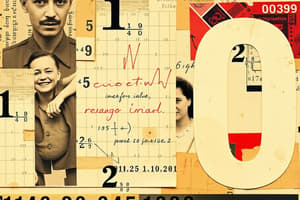Podcast
Questions and Answers
What does the hundreds place represent in the place value system?
What does the hundreds place represent in the place value system?
- Thousands
- Tens
- Groups of ten (correct)
- Single units
In the number 8,762, what value is each digit in the tens position?
In the number 8,762, what value is each digit in the tens position?
- 6 (correct)
- 2
- 7
- 8
How is the ones place represented in the number 4,321?
How is the ones place represented in the number 4,321?
- 4 × 100 + 3 × 10 + 2 × 1
- 1 × 1 (correct)
- 3 × 1
- 2 × 10 + 1 × 1
Which position in the place value system is marked with a comma to separate it visually from the next position?
Which position in the place value system is marked with a comma to separate it visually from the next position?
What does the 'thousands' position represent in the place value system?
What does the 'thousands' position represent in the place value system?
How does the place value change as you move from hundreds to ones?
How does the place value change as you move from hundreds to ones?
Which misconception about place value is addressed in the text?
Which misconception about place value is addressed in the text?
Study Notes
Exploring Place Value: Thousands, Hundreds, Tens, Ones
Place value is a fundamental concept in the world of mathematics, allowing us to represent numbers using symbols and understand their value within a number. In this article, we'll dive into the heart of place value, focusing on the four key positions—thousands, hundreds, tens, and ones—that make up our number system.
Thousands
Let's start at the top with the thousands position. A thousand is a thousand ones. For instance, the number 2,345 can be broken down as 2 × 1,000 + 3 × 100 + 4 × 10 + 5 × 1. The thousand position, often marked with a comma, provides a visual cue to help separate the thousands from the hundreds.
Hundreds
Just below the thousands position is the hundreds place, which represents groups of ten. The number 2,345 can be interpreted as 2 × 1,000 + 3 × 100 + 4 × 10 + 5 × 1. The hundred position uses a digit between 0 and 9 to represent the number of hundreds.
Tens
The third position in our place value system is the tens place. Tens represent groups of ten ones. In the number 2,345, the tens position is 3 × 10 + 4 × 1. The tens place uses a digit between 0 and 9 to represent the number of tens.
Ones
Finally, we have the ones place, which represents single units. In the number 2,345, the ones place is 4 × 1 + 5. The ones position uses a digit between 0 and 9 to represent the number of ones.
Place Value Interactions
As you move from thousands to ones, the place value grows smaller by a factor of 10. With each position, the digit signifies the number of the respective place value, i.e., thousands, hundreds, tens, and ones. The interactions between these positions allow us to represent large numbers easily and understand their magnitude.
Common Misconceptions
A common misconception is that the "thousands" position is actually a thousand. To clarify, it represents a thousand ones. Another misconception is that the place value system only works with four-digit numbers. In reality, it can be applied to any number, regardless of length.
In conclusion, place value is a cornerstone of mathematics, allowing us to represent numbers using symbols and understand their value within a number. By understanding the thousands, hundreds, tens, and ones positions, we can better comprehend complex numbers and perform calculations more efficiently.
Studying That Suits You
Use AI to generate personalized quizzes and flashcards to suit your learning preferences.
Description
Dive into the concept of place value which is essential in mathematics to represent numbers using symbols and understand their significance. Learn about the thousands, hundreds, tens, and ones positions in the number system, and how they interact to form larger numbers.




